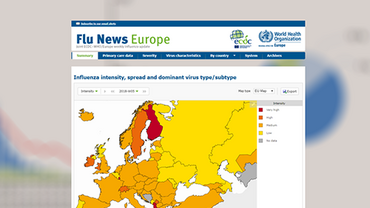Weekly influenza update, week 50, December 2017
ECDC and WHO/Europe publish weekly influenza surveillance data in the report Flu News Europe.
Summary
- Influenza activity was increasing in countries in Western Europe, Scandinavia and Turkey.
- Both influenza types A and B viruses were common and mixed patterns were observed across the Region.
- Of the individuals sampled, on presenting with ILI or ARI to sentinel primary healthcare sites, 26% tested positive for influenza viruses, significantly higher compared to previous weeks.
- Data from 19 countries or regions reporting to the EuroMOMO project indicated that all-cause excess mortality was within normal ranges for this time of year.
2017/18 season overview
-
An early risk assessment based on data from EU/EEA countries was published by ECDC on 20 Dec 2017. First detections indicated circulation of A(H3N2) and B/Yamagata viruses in the highest proportions. As the A(H3N2) subtype dominated last season, a high proportion of the population should be protected.
-
From sentinel sources, a slightly higher proportion of type B viruses compared to type A viruses has been detected. Approximately equal proportions of A(H1N1)pdm09 and A(H3N2) viruses have been detected.
-
For type B viruses from both sentinel and non-sentinel sources, B/Yamagata lineage viruses have greatly outnumbered those of the B/Victoria lineage.
- While low in number, 61% of the genetically characterized A(H3N2) viruses belonged to clade 3C.2a, the vaccine virus clade as described in the WHO recommendations for vaccine composition for the northern hemisphere 2017–18, and 39% to clade 3C.2a1, the viruses of which are antigenically similar to those of clade 3C.2a.
Other news
- The Norwegian Institute of Public Health has published an early risk assessment for the influenza season 2017/18 in Norway. See full report here.
- Influenza activity in the United States has been increasing since the beginning of November. Influenza A viruses have been the most commonly identified, with influenza A(H3N2) viruses predominating. See full report here.
- Additional information on global influenza activity is available from WHO’s biweekly global updates.







